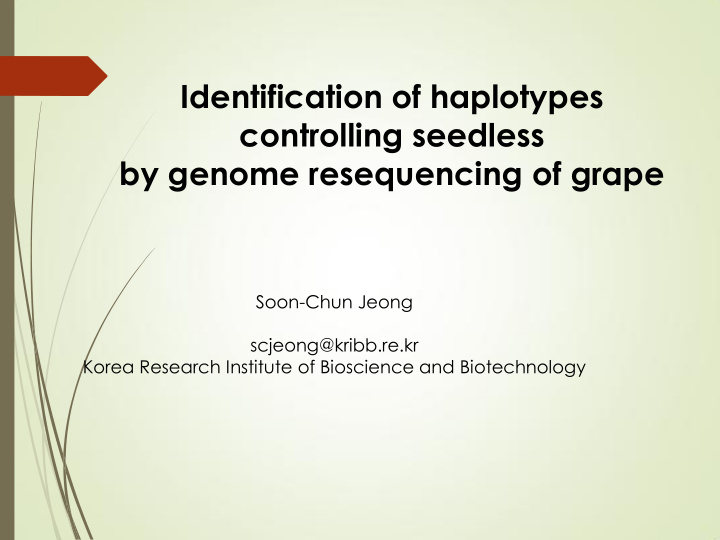



Identification of haplotypes controlling seedless by genome resequencing of grape Soon-Chun Jeong scjeong@kribb.re.kr Korea Research Institute of Bioscience and Biotechnology
Why seedless grape research in Korea? Among the three major uses for grapes, which are wine making, fresh fruit (table grapes), and dried fruit (raisins) production, most of grapes produced in Korea are for the table grapes Grape market size in Korea is approximately 400 million $ Because of concern of safety of gibberellin treatment, demands for stenospermocarpic seedlessness grapes are increasing
What we know about genetics of stenospermocarpy in grape? The most accepted model: Three independent recessive genes under the control of a dominant regulator gene named SDI ( Seed Development Inhibitor ) SDI Confirmed by numerous studies Localized on Linkage group 18 Explain 50% to 70% of the phenotypic variation of the stenospermocarpy VvAGL11 is the causal gene for SDI Expression in mature carpels, developing seeds and pre-and post versison fruits In silico mapping to the same contig that contains the SDI locus and the closest marker to a seedlessness QTL (Costatini et al. BMC Plant Biology 2008, 8:38) Genetic, physical, and transcriptional evidence (Mejia et al/ BMC Plant Biology 2011, 11:57) Ectopic expression in the Arabidopsis SEEDSTICK mutant (Malabarba et al. J Exp Bot 2017, 68:1493) The three recessive genes has not been identified at the molecular level
Objectives of This Study Identification of seedless-controlling haplotypes by genome resequencing of grape We have sequenced nine seeded and 16 seedless grape accessions and downloaded sequencing results of two seeded and one seedless grape accessions Flowchart of Grape genome analysis 1. Genome resequencing of germplasm 8 seeded grapes, 15 seedless grapes, 2 wild grapes; > 45x genome coverage 2. Variation calling Quality analysis of SNP array data, 3. Population analysis PCA, Admixture, phylogenetic analysis Current 4. Identification of haplotype stage SDI ( Seed Developemt Inhibitor ); haplotype network 5. Development of data mining tools Genome browser, massive candidate SNP/indels marker database
Variation calling results A total of 3,459,679 high quality SNPs were obtained from the sequencing data after filtration of > 5% MAF and > 10 % missing rate Name 0/1 1/1 ./. Autumn_Royal 760,823 343,351 16,583 Autumn_Seedless 909,474 271,196 10,451 Baily_Alic_ 369,733 99,201 312,934 Campbell_Early 337,221 192,400 332,142 Chardonnay_04 812,962 135,115 20,612 Cheongsoo 682,218 148,100 209,077 Crimson_SDS 1,051,043 222,627 10,362 Dawn_SDS 860,819 214,337 8,697 Fantasy_SDS 799,559 385,707 16,198 Himrod 890,334 111,590 134,321 Hongju_SDS 1,003,460 216,688 10,606 Italia 977,802 187,910 7,473 Kishm_Chernyi 895,976 233,290 13,529 Muscat_Alex 1,013,100 211,875 14,907 Perlon 1,057,453 204,043 11,726 Princess 894,136 296,969 8,967 RSDS_1 1,052,193 207,783 27,037 Red_Globe 1,052,793 208,076 26,799 Rizamat 841,037 222,048 25,717 Shiny_Star 891,726 168,600 56,274 Suffolk_Red 491,798 96,782 545,998 Sultanina 1,078,809 188,145 30,612 TR_1 768,515 142,841 158,203 Tamnara 166,899 102,340 612,310 Thompson_SDS 1,083,049 189,216 6,315 V_amurensis 43,452 127,916 346,529 V_flexuosa 41,594 41,093 484,314 Zinfandel_03 886,439 219,337 28,112
Population structure This population was divided into two or three subpopulations by the fastSTRUCTURE analysis
Phylogenetic tree construction Phylogenetic analysis supported two or 3 subpopulations Seeded and seedless grape accessions were not grouped separately s s e c Crimson SDS n i r P Muscat Alex Fantasy SDS Sultanina Suffolk Red Kishm Chernyi Thompson SDS 100 RSDS 1 Autumn Seedless 100 100 Autumn Royal 99 Red Globe 100 0 0 1 9 9 100 100 Baily Alic Italia 100 9 1 S 100 9 D 0 S 0 u j 100 g Chardonnay 04 n o 100 H Campbell Early s s i n 100 e r u Perlon m a V 0 S 0 1 D 1 0 V flexuosa S 0 n w 100 a 1 1 D 0 0 0 0 Tamnara H 100 i m 1 0 0 R r Shiny Star o 100 i z TR 1 d a m a t Cheongsoo Z i n f a n d e 0.0100 l 0 3
Phylogenetic tree construction Interestingly, in a tree that was constructed using SNPs from the 200-kb that contains the SDI locus in the middle of it, seeded and seedless grape accessions were grouped separately with an exception of Rizamat Whether Rizamat is mislabeled will be examined. 97 V amurensis V flexuosa 99 Campbell Early 97 Tamnara TR 1 Baily Alic Chardonnay 04 85 Italia 91 Muscat Alex 86 72 Zinfandel 03 48 Hongju SDS 97 Crimson SDS 43 Perlon 86 40 Fantasy SDS 54 Red Globe 86 RSDS 1 Himrod 11 Suffolk Red 23 Shiny Star 19 Autumn Royal 57 36 Cheongsoo Thompson SDS 54 31 Princess 43 Sultanina 25 Dawn SDS Autumn Seedless 46 Kishm Chernyi 58 0.002 83 Rizamat 0.002
Genome-wide association study We are working on GWAS, however, need to find an appropriate GWAS method
Conclusion and future works Diversity patterns of seeded and seedless grapes are consistent with the previous findings that the SDI locus is a major seedless-controlling locus Our future work will be directed to identify the three recessive genes, which are likely minor QTLs, using GWAS as well as diversity pattern analyses We will also catalogue the SNP and indel variation called from our resequencing data for use in grape breeding programs.
Contributors Soon-Chun Jeong Myung-Shin Kim Korea Research Institute of Bioscience and Biotechnology Youn Young Hur National Institute of Horticultural and Herb Science, Korea
Recommend
More recommend